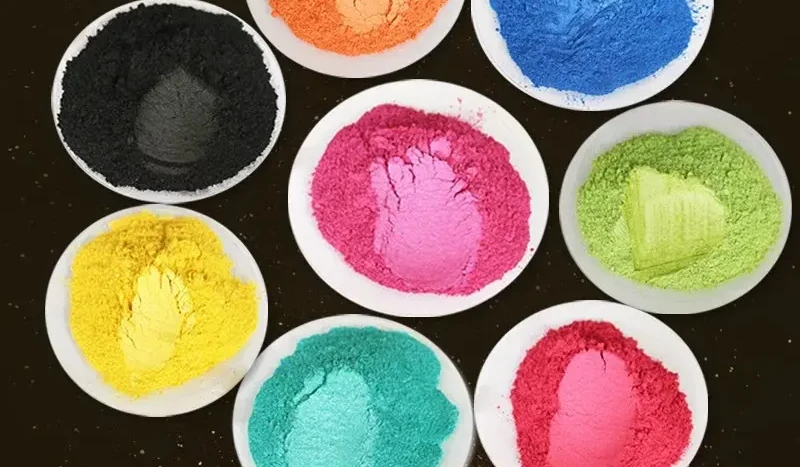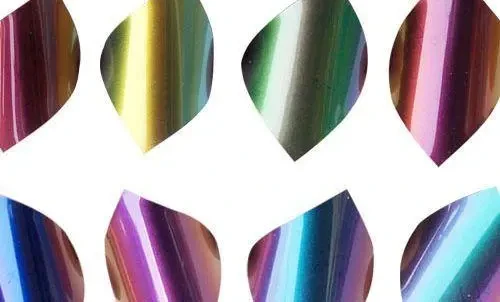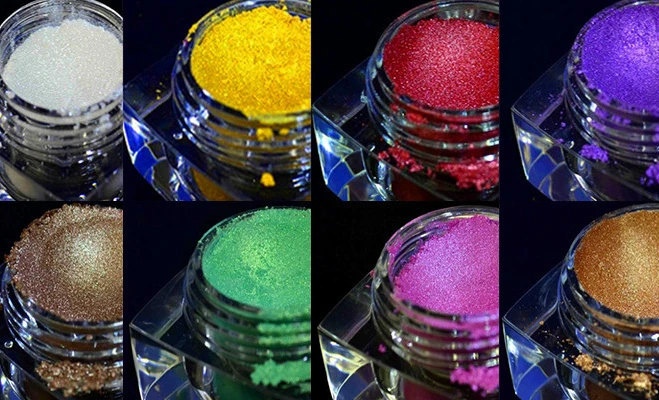What types of pearlescent pigment have been used?
The early natural pearlescent pigments contained natural pearl components derived from silver-white organic crystals found in fish scales or fish skin. As this kind of natural material has limited resources, with high production costs, and poor stability, so they were gradually replaced by synthetic pearlescent pigments. Synthetic pearlescent pigments mainly consist of mica pigments, bismuth oxide crystal pearlescent pigments, and lead carbonate crystal pearlescent pigments. Because bismuth chloride crystals have poor optical stability and durability, and lead carbonate crystals are toxic, the current market primarily features pearlescent pigments. They are made from non-toxic and easily accessible natural mica. Mica-based pearlescent pigments are the most widely produced and applied pearlescent pigments in the world It is characterized by being non-toxic, having good pearlescence, low bulk density, lightfastness, heat resistance, weather resistance, stable chemical properties. It is non-conductive, non-magnetic, with stable physical characteristics.

Based on these advantages, pearlescent pigments are widely used in coatings, plastics, automotive, cosmetics, inks, leather, ceramics, building materials, seeds, and other fields. The upstream of pearlescent pigments consists of natural mica and chemical synthesis products, while downstream applications covers coatings, plastics, automotive, cosmetics, inks, leather, ceramics, building materials, seed coating, and other industries.
What is the global market situation of pearl pigments?
In the entire pigment market, pearl pigments currently account for around 10%, but they have strong luster, excellent decorative effects, temperature and weather resistance, lightfastness, water resistance, and stable color fastness. They perform significantly better than other pigments like organic pigments. They are expected to replace other pigments in the future, increasing their demand ratio. Future automotive-grade and cosmetic-grade pearlescent pigments are likely to see increased penetration rates, while industrial-grade pearlescent pigments will benefit from expanding application areas. In recent years, the global pearlescent pigments market size has rapidly grown, 2.6 billion dollars in 2020, up 19.2% in compound annual growth rate from 2016 to 2020. It is expected to reach 6.11 billion dollars by 2025.
With the rapid economic development and consumer upgrades, the demand for pearlescent pigments will continue to rise. Pearl pigments are not only safe and non-toxic but also can produce multiple colors under light. These products can be used in high-end areas like cosmetics and automotive sectors. According to statistics, the market penetration rate of pearlescent pigments in cosmetic colorants rose from 28% in 2014 to 36% in 2018.
Mica is the main raw material for pearl pigments. Mica can be divided into natural mica and synthetic mica. With the depletion of natural mica resources, the penetration rate of synthetic mica has increased. In 2020, the global mica market reached 2.1 billion dollars, among which natural mica 54.1% and synthetic mica 45.9%. It is expected that by 2022, synthetic mica will surpass natural mica in market share.
Pearl pigments are an important application field for mica. In 2020, the global market share of synthetic mica-based pearl pigments increased from 5.3% in 2016 to 11.7%. And it is anticipated that the penetration rate of synthetic mica in the global pearlescent pigments market will further rise, reaching 23.6% by 2025. The pearlescent pigments industry is technology-intensive. The production of pearlescent pigments requires different production technologies to meet the needs of various downstream industries. The increasing share of synthetic mica-based pearl pigments is a future trend, and synthetic mica technology is the key to breaking into the high-end market. Only those who rank the top in the industy possess this technology.

The global high-end pearlescent pigments research and development and production have been monopolized by companies like BASF and technologically powerful top-tier firms in South Korea. Their performances have shaped their brand advantages.
Why is the pearlescent pigments industry considered to have high barriers, and what are these barriers?
Raw Material Barriers
The most crucial raw material for pearlescent pigments is natural mica. Due to restrictions on the mining conditions of natural mica, pearlescent pigment manufacturers largely depend on imports from countries like India and Brazil for their natural mica needs. Large-scale pearlescent pigment producers have long-term direct cooperation with natural mica suppliers. They gain advantages in raw material supply costs and stability. Additionally, because natural mica faces resource depletion and cannot meet the purity demands of high-end applications, companies need to use synthetic mica as raw material. Therefore, whether establishing a supply channel for natural mica or developing synthetic mica materials independently, serious industry barriers exist.
Technical Research and Development Barriers
Pearlescent pigments belong to a technology-intensive industry with complex production processes. For example, companies like BASF, Merck, and CQV all have proprietary intellectual property rights, especially concerning the core step of hydrolytic coatings. Whether it is raw material pretreatment or various process controls, a considerable amount of time and technical accumulation is required. Technical research and development lay the foundation for product quality. It determines product quality and corporate competitiveness, particularly for high-end applications in the automotive and cosmetics industries, which require high-quality and stable products. At the same time, there is a need to constantly enrich the variety of pearlescent pigments and accelerate product innovation. This requires manufacturers to continuously invest in research and development. Furthermore, to cope with the depletion of natural mica resources and in response to the demand for higher quality raw materials, pearlescent pigment manufacturers must reserve synthetic mica production technology.
Capital Barriers
The operation of pearlescent pigments requires advantages in branding, technology, and products. The operator needs to invest a lot in product research and development, production sites, manufacturing equipment, introduction and training of R&D personnel, marketing, import and inventory of raw materials, daily cash flow, etc. Moreover, the construction cycle for R&D is long, requiring significant upfront capital investment and working capital support. Thus, the pearlescent pigments manufacturing sector has a severe capital barrier.

Channel Barriers
Internet-savvy companies can continuously introduce new products and seize market opportunities. Without a complete sales network, products will be at a disadvantage in market competition, especially for pearlescent pigments where export volumes dominate. Establishing a sales network capable of facing international markets is a critical operational link. Major international pearlescent pigment buyers or traders usually set high entry thresholds for domestic pearlescent pigment manufacturers and have strict supplier qualification certification procedures. Companies need substantial financial investment to build stable and extensive sales networks and customer relationships. This requires long-term business operations to gradually improve and accumulate. The above requirements form a high market entry threshold at the channel level.
High-End Product Certification Barriers
For automotive pearlescent paints, since they need to withstand exposure to various complex weather environments for long periods, extremely high weather resistance is required. Strict control is exercised over product performance indicators, from raw materials to production processes and consistency and stability in downstream applications. European and American cars undergo five-year exposure tests in Florida, USA, and Iceland, Europe. A full certification cycle can last five to eight years. The strict product performance requirements plus the lengthy certification period erect extremely high barriersfor those who plan to enter the high-end product market.
Continue Reading
Pearl Pigment Applications: The Definitive Guide
How to use pearl powder for car paint?
Discovering the Brilliance of Pearl Car Paint
What is pearlescent ink: 5 things you need to know?



